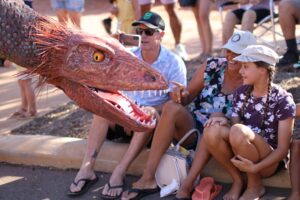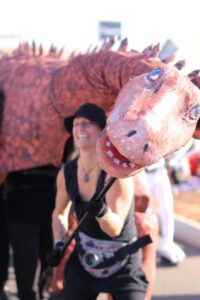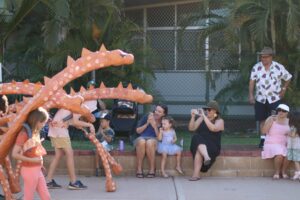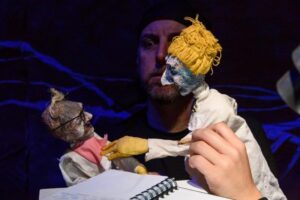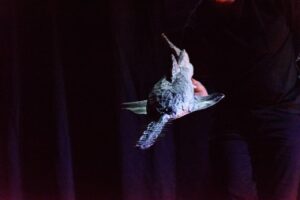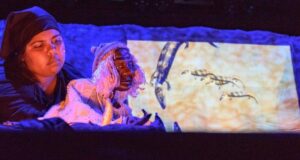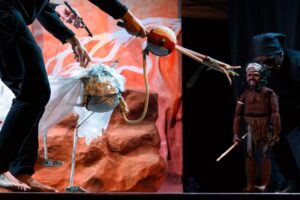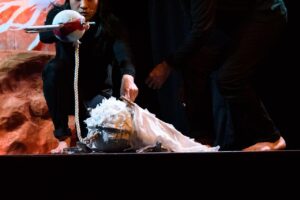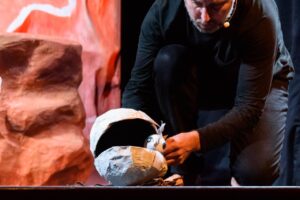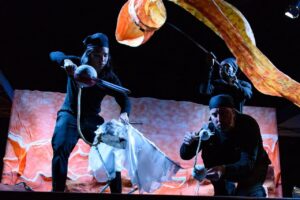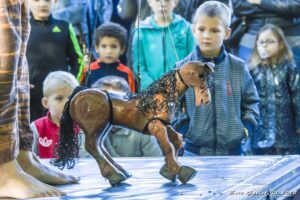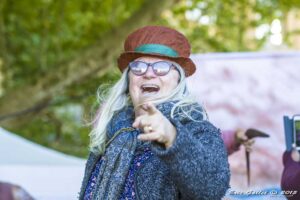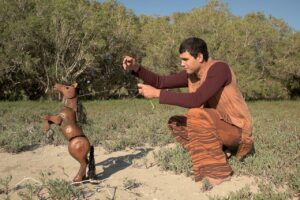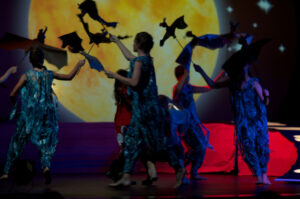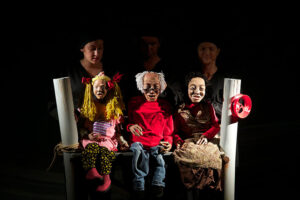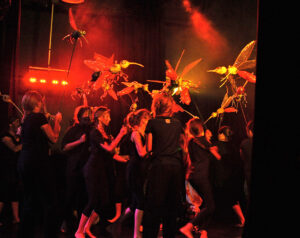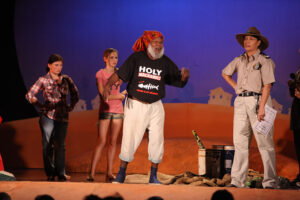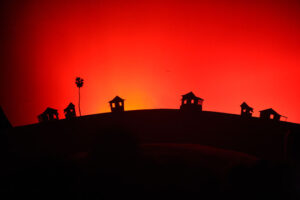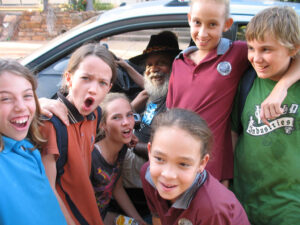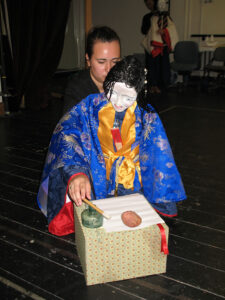- From 2020 – 2021
- Supported by Regional Arts Fund and Dinosaur Coast Management Group.
- Puppet construction by Chris Hill and Gwen Knox
- Photos by Georgia Deguara
Puppetry
Song for the Martuwarra
Song for the Martuwarra
Song for the Martuwarra is an extremely beautiful puppetry work suitable for all ages. It an exciting example of inclusive theatre where it can engage and work with the community on a number of entry levels from: puppetry and science workshops with children, those children have the opportunity to participate in the show. It can feature river stories from local rivers where the performance will take place. It can be easily redesigned to be a site specific – community performance. Alternatively the performance can stand alone.
A ceremony in 2014 exchanging river water from each river by elders of the Indigenous Nyikina people from the Fitzroy Valley in Western Australia and the elders of the French Ardennes was the impetus for “Ngalyak and the Flood” and this project to develop further understanding of the universal importance of both river health and the art of storytelling to connect with our natural environments.
Song for the Martuwarra tells part of the story from the Warloongarriy Law Songline. Woonyoomboo the first ancestor, who long, long ago in the beginning of time, went searching for food and water and travelled between living water billabongs. Woonyooomboo was responsible for causing two giant serpents to escape from one of the billabongs, which carved a river and split it into two, forming parts of the landscape along the Martuwarra – Fitzroy River. He calls everyone to come to the river and to know how important it is to value, respect and protect the river.
Nyikina people believe that the rainbow serpents still live in the river. The serpents are named Yoongoorrookoo. When people behave disrespectfully, Yoongoorrookoo can get very angry and may drown somebody or cause a flood. Yoongoorookoo and Woonyaoomboo meet another river who is not doing so well.
This cautionary tale pays homage to the way that culture has shaped country and how country shapes culture.
This work compares shared stories and is a potent warning about the importance of caring for country and culture. It encourages us to begin listening to nature again.
Children have helped shape this work. It includes some of their stories that are told beside more ancient ones. “The Song for the Martuwarra” is sung by the children of Broome Primary School in Western Australia.
This work is available for touring from February 2019
Specs
Stage size 5m x 5m Minimum Height 3m (black box)
Masked wing space,
Number of professional performers: 4
Venue supplies: Lighting as per plot, Sound system, projector set, 3 head set mikes, projector
Audience size 150 -200+ Depending on site lines
For more information Please contact: gwendolyn@westnet.com.au
Proudly supported by
Ngalyak and the Flood
There is an old Nyikina man who sits under a tree carving wood with his old pocket knife.
As he carves he tells the story of Ngalyak or the Luma Lizard. He cracks jokes and laughs a lot. Next to him is his bag of tools and a collection of lizards that he has already made. As he talks, his lizards begin to take life of their own. And crawl out his bag.
He tells the story of the changing seasons and the flow of Mardoowarra the mighty Fitzroy River that for most of the year has been a dry hot river bed. When it floods it can be over 20kms wide in places.
He tells how a woman became a lizard or Ngalyak or Luma or bobtailed lizard.
They know the rain is coming because they can hear the thunder in the distance and see the big clouds filling the sky.
And the Green tree frogs have been calling the rain.
Once the rain begins the grass grows and all the creatures come to have a feast. The Frogs party all night long. The cicadas shed their skins and start their deafening harmonic buzz as they beat their body drums. The frilled neck lizard hunts them for lunch. He wears his mating colours on the chance that he will meet a nice lady while he is doing it.
The Flying foxes fight all day as they hang in the trees along the river until they take flight at sunset to feed on the ripening fruits of the bush trees.
The high pitched alarm of the mosquitoes can be heard as they look for fresh blood to suck.
The big old goannas (Perenties lizard) hunt the juicy bugs, the people hunt the big old goannas.
The Brolgas dance their courting dances on the floodplains.
The woman is about to have her babies and knows that the river will flood soon. She must not let her babies drown. She travels down the dry river bed. Very soon the rain fills the river and it starts to flood. She begins to swim. As her babies are born she carries them on her back across the country down the flooding river. (NB Blue Tongues give birth to live young)
With the flood waters came millions of incredibly beautiful microscopic creatures called diatoms. They do not exist if the water in which they live they is not healthy. They underpin all life on our planet.
The flood waters washed the mother away and she became a sand dune. Her children crawled up onto the rocky cliffs and waited for their mother to return. They have waited for so long that they have turned into stone. Another name for the Ngalyak is the Luma lizard. The little lizards still watch over a small town that has taken its name from them. It is called Looma.
Photos by Rachel Taylor and Eric Gallet.
“Two Rivers Talking” Puppetry Workshops
“Two Rivers Talking” puppetry workshops with the Pandanas Park kids in the second week of the last school holidays. Great fun with Bernadette Agatha Trench-Thiedeman and Karen Hethey, Anne Poelina, Meredith Bell
Even Jabby came out of his suitcase!
thanks Danielle Odore and tropical upholstery for all the foam.
Staircase to the Moon
Based on the children’s book of the same name by Indigenous local author Bronwyn Houston, Gwen Knox is writer director of the play. The story is inspired by the natural phenomenon of the staircase to the moon where the moon reflects on the mudflats at low tide on Roebuck Bay, Broome.
The great music written by local, famous Indigenous musician Lorrae Coffin
The play features articulated boab and frangipani costumes by the very clever puppeteer Karen Hethey. There are a large number of puppets that have been developed in workshops with the amazing Sandy McKendrick and the in workshops with young performers who make up the large ensemble of puppeteers and dancers. Gwen Knox created the three main characters puppets.
- 2012 performers Jub Clerc, Neil Turner, Tahya Jamieson, Maeve Driffle, Musical Director and composer Lorrae Coffin, band members
Ralph Bermann, Toby Prewitt , Steve Angoorly. - 2014 performers: Ninian Donald, Susie Quicke, Wenonah Cardenas, Dale Kelly. Musical accompanist Rob Pascoe.
- Artists working on the project: puppets by Sandra McKendrick, Karen Hethey, Gwen Knox , Choreography by Claudia Alessi, Design and construction Chris Hill, Lighting Andrew Chambers and Rick Turner
A Ship of Dreams
A Musical Drama for Children
Written by by Mary Durack, With Music by June Fitzgerald, Adapted by Gwen Knox 2008, musical director Damion Watkiss.
Gwen performed in the original production in 1968. She was thrilled to be able to adapt and direct the 2008 production.
When this play was first performed in 1968 it was a major event in the town. Civic fathers decided it would be good to have a regular event to help create a tourist industry. And Shinju Matsuri was born.
Many of the original cast went on to pursue and have very successful careers in the arts.
Photos by Leon Meade Photography
Starring: Stephen Baamba Albert, Rohanna Angas, Mark Cole-Smith, Craig Marvel, Lesley Marsh.
Carnival of Light
200 hand made and hand held lanterns, several large lanterns, 200 children and 30 adult voice choir, live band made up of key Broome musicians, dancers and fire twirlers made up an truly magical performance on the mud of Roebuck Bay during the Shinju Matsuri 2012.
The performance was adapted from one that Gwen helped write and direct in 1996 titled “Stories from the Mangroves”. This time choosing only 3 of the songs that were written by Lorrae Coffin and Lyn Hazelton taken from oral histories that Lorrae and Gwen collected as part of the project development.
Photographer ~ Leon Mead
Musical Director ~ Susie Quicke
Lantern Maker and Co Director ~ Chris Hill
Shadows, Dreams and Memories
Traces the story of Japanese woman who lived in Jap Town, Broome in the early 20th Century. Her man is at sea. She writes him letters of love until she receives a letter to confirm that her man has been lost forever to tragedies that often stalk the pearling industry.
Excerpts performed at UNIMA Perth in 2008
Jabby
Jabby is a puppet character created by Gwen Knox.
He is based on the old Aboriginal men that had such an impact on Gwen’s childhood as the daughter of a Kimberley cattle station manager and butcher, men that taught her to ride horses and filled her head with stories.
The name Jabby comes from the Walmatjarri (south of Fitzroy Crossing) word for grandfather “Jappi”. He is a generic Aboriginal man who has retired from the life of a stockman on a Kimberley cattle station. As a puppet, his initial role was, and still is that of a storyteller and demonstration model when Gwen teaches puppetry in schools and community workshops.
He has taken on the role quite accidentally with the help of his grandson “Nyili”, as a health promoter in trying to educate people about:
- Trachoma creation of a short film called “Jabby’s Friend” video by Desert Pictures and Gwen Knox for Kimberley Public Health
- Smoking awareness making puppets with Members Kadjina Community resulting in an education package and film “Jabby Don’t Smoke” and extensive TV advertisements by Desert Pictures, Gwen Knox for Kimberley Public Health.
- Scabies, making puppets with residents of Wingalina community, Central Australia resulting in an education package and film “Under you Skin” with Desert Pictures.
- Use of seat belts and installation of car ute role carriages for carrying people on the back of utilities (this TV advertisement won an award).
As part of the Jabby don’t Smoke project (sponsored by Healthway and Kimberley Public Health) Gwen ran Puppet making workshops at Wulungarra School in Kadjina Community south of Fitzroy Crossing, facilitated writing the script, and coordinated community members as puppeteers and voice overs to perform for a twenty minute video. Out of that project Jabby acquired a wife “Ngunju” (pron. Ngoonjoo) two sons a daughter, a nephew and a new magic grandchild “Larmparrn”. All new puppets remain the property of the people who made them.
Gwen has made other “Jabbys” along with other puppet characters as part of puppet kits to be used in schools to promote understanding of “code switching” in language use with Indigenous children from non English speaking backgrounds. For example, students use the various puppets, be they Jabby, a European schoolteacher, a court judge, and Aboriginal health worker to identify the different Traditional languages, levels of English and Kriol language used and to learn appropriate language behaviour for a variety of occasions.
Jabby is a very popular character. For example: On a trip to Wingelina near the Northern Territory, South and West Australian border, he upstaged, by accident, the federal minister for education who was also visiting the community.
Jabby’s image has been reproduced into posters, stickers, pencils, hats and screen savers, and TV advertisements.
Gwen wrote a song to go with the “Jabby Don’t Smoke” project that was used in the advertisement. It became the most requested song on the children’s hour on Radio Goolarri (Broome’s Community Aboriginal Radio) Gwen has children (and often their parents) stopping her in shopping centres all over the Kimberley so they can sing the song to her.
When Jabby appears people reach for him and instantly treat him like an old friend.
The following is some informal feed back received during the question and answer sessions at the end of the puppet show and in talking to teachers.
Jabby’s grandson pictured here with Gungi Laurel. The puppet arrived at Kadjina Community nameless. The men of the community had a discussion in good fun and decided with much amused solemnity that his name should be Nyirrli. We had a naming ceremony complete with cups of tea.
- It is the most relevant piece of educational theatre I have ever seen. (teacher)
- Jabby is my favourite puppet (a common sentiment from 100’s of children)
- Hey who am I ? (teachers husband imitating Jabby driving the Toyota when they were on a camping trip.)
- This is fantastic, the students were captivated all the way through.(teacher)
- Oh thank god you’ve got here, The kids are driving us nuts with asking “When is Jabby going to get here?” (a common teacher greeting when we arrived at a school)
- “I liked the bit where Jabby said he gave up smoking because the bull got him up the bum and now he can run really fast….. but he’s old….Miss, how can he run really fast?” Child 2 “No silly he was telling a true story but he exaggerated to make it more interesting for us. That’s why Ngunju growled at him for telling fibs. It was a story about when he was young. He could chuck a bull over the fence then couldn’t he Miss.” (two students discussing the puppet show)
- I liked it when Clinton got the Goanna ‘cos he stopped smoking. (a popular response.)
- I liked to see Aboriginal puppets. (High school student)
- How come you see these people jogging, and popping health pills end everything then you see them smoking. I think that’s really stupid of them. (high school student)
- How can you stop your parents from smoking? I hate it! (a common question)
- I loved this show. I wish more people could see it. My mother died from cancer last year, she was always smoking. I hope my kids have taken notice. (Aboriginal mother watching the show.)
- What’s Jabby made from? (One of the most popular questions.)
- Can Jabby come and look at the students work? (teacher)
- “Nah I think we’ll only have the one show. We had this other crazy puppeteer here last week and the kids ran riot!” after the first show “Hey this is fantastic, the other classes will mutiny if they miss out.”
- Can we do the song for our assembly item? Can you teach me the chords? (several teachers.)
- I like the use of language. English, Kriol and recognisable Aboriginal words (teacher)
- My granny is just like Ngunju. She’s always looking for tobacco to chew and telling us kids to go and get it for her.(student)
- How can we say no to our parents when they tell us to go and get the tobacco and smokes? (student)
- Hey listen to Jabby, he’s your man! Your crazy if you start smoking!(Tony Modra from the Dockers football team to a group of high school students)
- Oh! (squeel) Tony Modra shook Jabby’s hand and said that? Oh (sigh) can I shake that same hand. I’m giving up smoking today! (teacher in the staff room)
Jabby Don’t Smoke by Gwen Knox
(To be played with feeling, and a slow country feel. Twangy out of tune guitars welcome.)
Chorus x2
G
Jabby Don’t Smoke
Jabby don’t chew,
D G
This old man knows what to do
Verse
G C G
He’s got to tell all the young kids
D D
not to make a start.
C G
It’s bad for your lungs
D G
Its bad for your heart.
Chorus x2
Verse
G C G
He’s got to tell all the people
D G
that tobacco is wrong.
C G
Tobacco will kill you
D G
you must stay strong
Chorus x2
Crabbing At High Tide
With Barking Gecko Theatre Company and Magabala Books.
Co-designed with Chris Hill and puppets by Gwen Knox.
Perth International Arts Festival and WA Tour 2007



